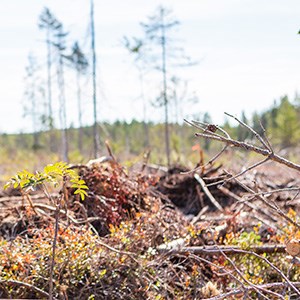The forest needs nutrients such as nitrogen and phosphorus to grow. While nitrogen has been the subject of much research on boreal forests over the years, phosphorus has been almost neglected. However, phosphorus is an essential nutrient that is decreasing in boreal forest soils, which calls for more knowledge on the mechanisms behind phosphorus availability. This is important in order to secure the nutritional needs and growth of trees in a long-term perspective.
The majority of phosphorus is less available to trees
Marius Tuyishime, PhD student in soil chemistry, has used advanced methods – including X-ray absorption spectroscopy – to study seven podzolized soils across Sweden. In podzolized soil, a large amount of phosphorus is fixed to aluminium and iron-containing minerals, which makes phosphorus less available to trees.
-There is a large phosphorus stock in the subsoils compared to the topsoils, although about 60% of it is less available due to podzolization and weathering.
Reliable knowledge on phosphorus forms
By using X-ray absorption spectroscopy, Marius Tuyishime has been able to identify forms of phosphorus in soil samples. The resulting results are reliable as this technique, contrary to other techniques, allows untreated samples to be analyzed. This is the very first time different forms of phosphorus, particularly inorganic phosphorus, in boreal forest soils have been identified with such high reliability.
-An important question is how we can manage forests in a way that ensures optimum phosphorus availability for plant and tree growth. In other words, how can we make unavailable forms of phosphorus available? To answer this question more research is needed on phosphorus cycling in the forest ecosystem, Marius Tuyishime explains.
Moderate amount of ashes recommended
When trees are harvested, their needles and branches, and sometimes stumps – which are rich in phosphorus– are often removed from the site and used for bioenergy production. This decreases the amount of available phosphorus. To restore the phosphorus balance in forest soils after harvesting, the wood ash from bioenergy production can be recovered and applied to the forest again.
To increase the knowledge on what happens to the phosphorus in the soil when ashes are added, Marius Tuyishime studied changes in phosphorus forms in the organic layer of two wood ash-fertilized forests. X-ray fluorescence and X-ray absorption spectroscopy were used to study micrometer-sized areas in samples to allow for a detailed observation of how different forms of phosphorus changed after wood ash fertilization. According to the results, wood ash increased the amount of phosphorus in the top soil by between 17 and 39%, and at the same time the amount of available phosphorus and the uptake by trees increased.
-Our recommendation to forest managers is to add a moderate amount of wood ash in combination with nitrogen. This will not only increase the available phosphorus and the tree growth but also lead to less build-up of unavailable phosphorus.
Benefits sustainable forestry
These new findings about phosphorus availability and wood ash application to boreal forest soils can be useful in improving forest management practices to ensure nutrient availability, uptake and recycling.
-We have never before known so many details about phosphorus cycling in boreal forest soils as we do now. Our results are an important step into the direction of sustainable forestry, says Marius Tuyishime.



